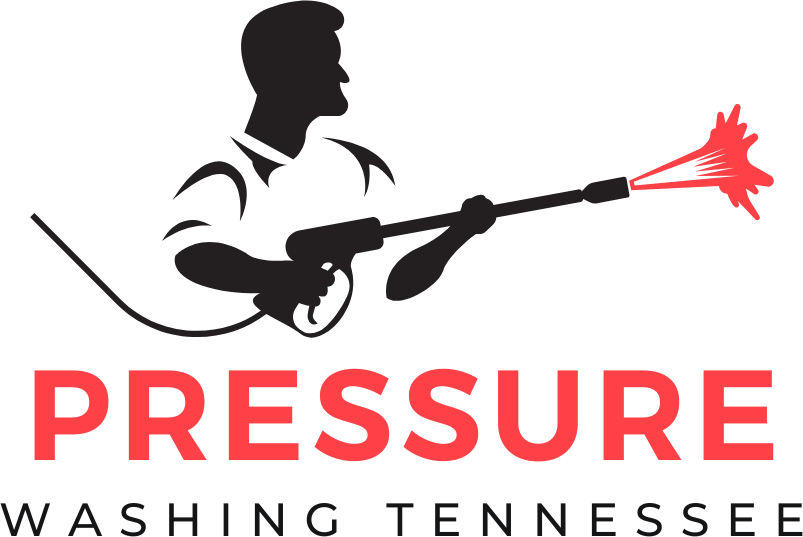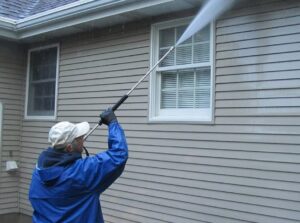When I look at a roof covered in grime and streaks, I know it’s not just about curb appeal—it’s about protecting your biggest investment. In Tennessee’s unpredictable climate, mold and debris can quickly take over, threatening both your roof’s lifespan and your home’s value. That’s why pressure washing isn’t just a quick fix—it’s a smart move.
I’ve seen firsthand how a professionally cleaned roof transforms a property and saves homeowners from costly repairs down the road. If you’re wondering how to get those results safely and effectively, you’re in the right place. Let me show you why pressure washing your roof the right way matters and how you can do it without risk.
Understanding the Basics of Pressure Washing Roofs
Pressure washing roofs keeps surfaces clear of algae, moss, and dirt, especially across Tennessee’s varied weather patterns. Using this cleaning method helps tackle grime that rain, humidity, and falling leaves leave behind. Water sprayed at high pressure lifts debris from shingles, restoring the roof’s look in a short time.
Getting the right tools makes a difference. I choose a pressure washer with a wide spray nozzle and set it to a lower PSI—usually under 1,500 PSI—to avoid damaging asphalt shingles or tiles. Using gentle cleaning solutions, like a mix of water and roof-approved detergent, boosts the cleaning power without hurting plants or wildlife nearby.
Safety is always a priority before I start. Securing a sturdy ladder, wearing non-slip shoes, and checking the weather prevent mishaps. Protecting nearby plants and covering sensitive areas around the home also reduces accidental damage from water runoff or cleaning agents.
Regular pressure washing keeps the roof in good shape, preventing growths that trap moisture and lead to costly repairs. For Tennessee homes, scheduling this service once a year, like after pollen season or following heavy storms, provides the best results.
Why Roof Cleaning Is Essential in Tennessee
Tennessee’s humid summers and mild winters create an environment where moss, algae, and lichen grow quickly on rooftops. Over time, these organisms trap moisture against the shingles, which weakens the roof’s surface and leads to leaks or early replacement. I often see dark streaks caused by algae, especially on north-facing slopes, and they don’t just look bad—they also absorb heat, raising cooling costs during hotter days.
Dirt and fallen debris from seasonal storms add extra weight on the roof and clog gutters. Left unchecked, this buildup encourages wood rot under shingles and attracts pests like termites. Clean roofs improve a home’s curb appeal, which makes a real difference if I plan to sell or just want to take pride in my property.
Annual cleaning also helps me spot small issues—like cracked or loose shingles—before they turn into bigger repairs. Maintaining a clean roof keeps my insurance valid, since neglect can void some policies if damage is judged as preventable. Regular cleaning is part of protecting the investment I make in my home, making sure it stays solid year-round even though Tennessee’s unpredictable weather.
Risks and Considerations When Pressure Washing Roofs
Pressure washing a roof in Tennessee brings unique challenges worth keeping in mind. Water pressure that’s too high can strip protective granules off shingles or leave cracks on tiles. Moss and algae might seem easy to blast away but, if not handled gently, I could unintentionally cause leaks or loosen roofing materials.
Wet, sloped surfaces get slippery fast, especially after spraying. Losing footing on a damp roof is a real risk, so sturdy shoes with good grip become a must. Electrical lines close to the roof edge require extra attention since water and power don’t mix well.
Nearby landscaping suffers if runoff from cleaning solutions reaches delicate plants. Even mild detergents wash chemicals into gutter systems and out across lawns unless I protect these zones ahead of time.
Older roofs or those with small repairs often hide weak spots. High-powered washing exposes loose or brittle shingles, and I might discover minor issues turning into bigger problems during cleaning. Checking the age and condition of the roof before starting helps me avoid any surprises.
Most insurance policies stay valid only when roofs get proper maintenance, yet overzealous cleaning sometimes voids a policy. Careful planning and gentle cleaning methods help protect my home’s investment from both structural issues and coverage hassles.
Choosing the Right Equipment and Cleaning Solutions
Pressure washing a roof in Tennessee means picking tools and cleaners that get results without causing harm. I check the equipment and cleaning solutions first to keep shingles safe and surfaces looking sharp.
Types of Pressure Washers
Electric pressure washers work well for most residential roofs because they’re lightweight, easy to control, and run at lower PSI levels. I like to use washers that let me adjust the pressure, keeping it under 1,500 PSI. Gas models, while stronger, often deliver too much force for shingle or tile roofs and can lead to damage if not managed carefully. For extra reach and less climbing, I prefer models with long extension wands so I stay firmly on the ladder or ground.
Recommended Cleaning Agents for Roofs
Choosing gentle, roof-safe cleaners helps avoid streaks and damage. I use biodegradable cleaning agents labeled as safe for roofing—these break down moss, algae, and mildew without hurting nearby plants. A mix of water and oxygen-based bleach often works best for removing tough stains, leaving surfaces clean while protecting the environment. Avoiding harsh chlorine bleach keeps roof materials from deteriorating and stops runoff from harming local wildlife. For sensitive areas or eco-friendly needs, I stick with specialized roof detergents made for homes in humid regions like Tennessee.
Step-By-Step Guide to Pressure Washing Roofs Safely
Getting ready to pressure wash a roof in Tennessee means focusing on safety and method. I use a simple approach to make every step straightforward and effective.
Preparing Your Roof and Work Area
I start by clearing the roof of loose branches, leaves, or heavy debris. Nearby plants and shrubs get covered with tarps to shield them from runoff. I check that the ladder stands firmly on level ground, then double-check for stable footing before climbing. When I gather my gear, I make sure to wear non-slip shoes, gloves, and safety glasses. I also unplug any exterior lights or accessories close to the cleaning area.
Proper Washing Techniques
I keep the pressure washer’s PSI below 1,500 and always use a wide fan tip. Holding the nozzle a few feet from the shingles, I aim at a downward angle to guide water away from the roofline. I choose smooth, overlapping strokes and never let the spray linger in one spot. For tough algae spots, I spray a roof-safe cleaning mix, wait 10 to 15 minutes, then rinse gently. I work from the top down to avoid pushing water under the shingles.
Post-Cleaning Inspection and Maintenance
Once the roof looks clean, I remove debris from gutters and downspouts. I scan for damaged shingles, soft spots, or raised nails. If I spot any leaks or odd stains, I note them for repair or professional follow-up. I finish by carefully removing all tarps and checking garden beds for any chemical residue. Regular checks, especially after major storms, help the roof stay in top shape all year in Tennessee.
Safety Tips and Common Mistakes to Avoid
Staying safe on a roof in Tennessee means being thoughtful before you start. I always check the weather first since rain or high winds make everything riskier. Dry, clear days provide the best conditions for pressure washing.
Wearing sturdy shoes with good grip helps keep me steady on shingles. Gloves, safety glasses, and long sleeves protect from flying debris and splashing cleaner. Before turning on the washer, I move ladders carefully and make sure they’re on level ground.
Covering plants and shutting windows keeps cleaning solution where I want it—just on the roof. Nearby power lines can be dangerous, so I pay attention to their placement and avoid spraying near them.
Keeping the pressure low is important. Using a setting over 1,500 PSI increases the chance of damaging shingles or knocking them loose. Instead, I stick to broad spray patterns and avoid blasting straight up under roof edges or tiles.
Some common mistakes are easy to avoid. Spraying from below forces water under shingles and causes leaks. Rushing over moss or algae patches usually leaves slippery residue behind, so I take it slow and let the cleaner sit for a few minutes on tough spots.
Checking the roof’s condition before starting makes a big difference. If I spot loose tiles or weak areas, I address those repairs first instead of risking bigger problems.
After finishing, cleaning up the work area and rinsing off nearby plants helps keep everything healthy. With these habits, I make sure pressure washing protects my roof without causing unexpected damage.
Hiring Professional Pressure Washing Services in Tennessee
Bringing in a pro pressure washing service in Tennessee makes roof cleaning straightforward and reliable. Local roof cleaners use equipment tailored for different roof types and know how to protect shingles, gutters, and landscaping from unnecessary damage.
Experienced companies in Tennessee often assess a roof before starting. They check for loose shingles, weak spots, and overhanging branches that might complicate cleaning. Familiar with the region’s humidity and storm patterns, these crews choose cleaning solutions that clear away algae and moss while preserving your home’s exterior.
Many services offer both soft washing and pressure washing options. Soft washing involves gentle cleaning with specialized solutions, perfect for asphalt shingles or older roofs that need extra care. When I work with a reputable provider, I can expect them to adjust water pressure and apply safe, EPA-approved detergents to minimize risks.
Professional cleaners also handle safety challenges, including steep pitches or roofs near electrical lines. Most carry liability insurance and worker’s compensation, so I avoid the risks tied to DIY roof cleaning. Crew members use harnesses, ladders, and non-slip gear, reducing the risk of accidents. Plus, services often include gutter clearing and post-wash inspections for leaks or damage.
Getting a detailed estimate before booking helps set clear expectations. Reliable Tennessee providers explain their cleaning process, outline what’s included (like debris removal or plant protection), and provide written quotes. Looking at online reviews and checking references keeps my selection process easy.
Choosing a local pressure washing expert means my roof gets cleaned without the stress or mess, keeping my home safe and looking its best.
Conclusion
Taking care of my roof in Tennessee means more than just keeping it looking good—it’s about protecting my home and my investment. With the right approach and attention to safety, pressure washing can make a big difference in preventing long-term damage. Whether I choose to tackle the job myself or call in professionals, I know that regular maintenance is key to avoiding costly repairs and keeping my property in top shape.


